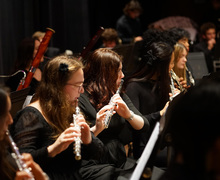‘Forbidden Fruit: Yasuo Kuniyoshi’s America’ pushes dialogue on history
Courtesy of SU Art Galleries
Japanese artist Yasuo Kuniyoshi was born in 1889 in Okayama, Japan. His art was inspired from those around him and social realism.
Down the winding corridors of Shaffer Art Building, past a vast collection of ancient clay and pottery pieces, is a room with an entirely different, and unique, art exhibit.
“Forbidden Fruit: Yasuo Kuniyoshi’s America,” featuring work by Japanese artist Yasuo Kuniyoshi, is in this room. It has been a long-term project of curator David Lake Prince — it took him 37 years in planning and preparation.
“You immediately notice the somber tone. I think this is partly due to the room itself and its lower ceilings, but also the tone in the writings of the exhibit,” said graduate student Lynn Smith.
Prince, associate director and curator of collections at SUArt Galleries, was immediately drawn to the image of the “sickly” boy in Kuniyoshi’s oil-painting of a boy eying a stack of halved watermelon slices.
“I wanted to, from an art history perspective, know why it looked the way it did. It seemed to reflect the trials he endured after Pearl Harbor as a Japanese man,” Prince said.
Kuniyoshi was born in 1889 in Okayama, Japan. As a young man, he developed his style of social realism, depicting the lives of individuals around him. Prince said most of these were pen-and-ink with minimal paint, but as he gained confidence, Kuniyoshi put more of his own identity into his work.
“What made him so valuable is he took modernism and inserted Japanese style into them,” he said.
In 1923, early in Kuniyoshi’s career, he made a similar painting to “Forbidden Fruit,” entitled “Boy Stealing Fruit,” in which a boy can be seen successfully stealing a banana and apple.
Prince said that after moving to the United States, Kuniyoshi faced issues in the artistic world, given that abstract expressionism was the popular style. These pressures caused him to begin to paint with more vivid colors than his traditional browns and jades.

Laura Angle | Digital Design Editor
But his world was turned upside down after the Pearl Harbor attacks, having to deal with both hatred and discrimination as a Japanese artist. In 1950, as if in response to his changing world — in the realm of both society and art — Kuniyoshi painted his most thought-provoking, abstract work: “Forbidden Fruit.”
Prince has his own theory about the connection between the two “fruit” paintings.
“I think the boy successfully stealing the fruit is Kuniyoshi and the fruit represents assimilation into American culture,” Prince said.
In the painting completed three years before his death, Prince said he believes the fruit represents citizenship — which Kuniyoshi never received in the U.S. because of increased fear of communism.
In coming weeks, freshmen will be able to see the gallery for themselves through the first-year forum, in which Prince will deliver a lecture about the ”Forbidden Fruit” exhibit, focusing on how artists use visuals to express themselves. Emily Dittman, collection and exhibition manager at SUArt Galleries, said most new students don’t know the galleries even exist.
“Kids have classes in Shemin Auditorium and most kids don’t know we’re here,” Dittman said. “Sometimes, though, kids will wander in and ask if there’s an entrance fee.”
The gallery hosts three major shows during the year, in addition to a fourth that allows students in the College of Visual and Performing Arts to showcase their work. At 12:15 p.m. every Wednesday, they hold a lunchtime tour of the gallery, usually focusing on one exhibit.
Funded by both donors and university grants, Dittman considers it a “teaching museum,” meaning that the resources they have are meant to be utilized by students.
“I like being on a university campus because the students are doing the research on these pieces and teaching us as well. Learning is a two-way street here,” Dittman said. “Our number one mission is to serve the ‘Cuse community, staff, faculty and students.”
The exhibit is open through Nov. 18, Tuesday to Sunday, from 11 a.m. until 4:30 p.m. and Thursday until 8 p.m. It’s free to students and the Syracuse community.
Published on September 19, 2018 at 9:53 pm







